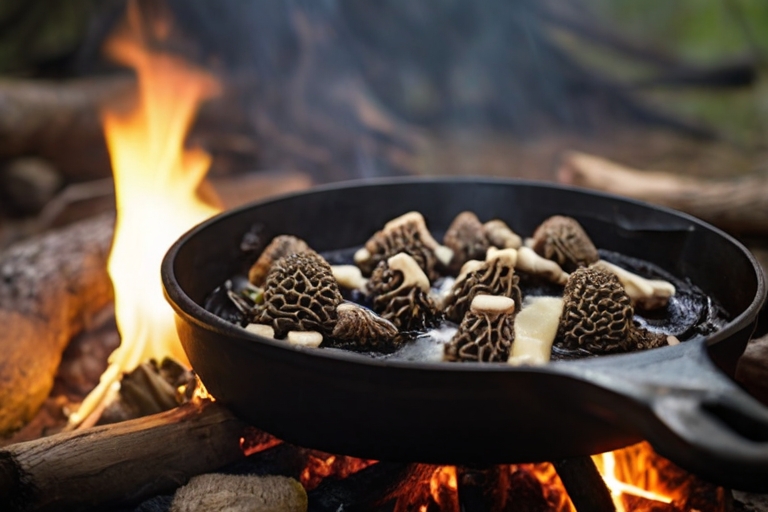Hunting and Fishing News & Blog Articles
Morel Mushroom Hunting: A Guide to Finding, Identifying, and Enjoying Nature's Treasures
Introduction to Morel Mushrooms
Morel mushrooms, often hailed as nature's delicacy, are prized by foragers and culinary enthusiasts alike for their unique flavor and texture. These elusive fungi are a favorite among mushroom hunters, drawing them into the depths of forests in search of their earthy treasures.
Characteristics of Morel Mushrooms
Morels are distinguishable by their cone-shaped caps with a honeycomb-like appearance. They typically range in color from light tan to dark brown and can vary in size from a few inches to several inches tall. These mushrooms prefer specific habitats, including wooded areas with moist soil and a mix of deciduous and coniferous trees. Morels typically emerge in the spring, with their seasonality varying based on geographic location and weather conditions.
Gear and Equipment for Morel Mushroom Hunting
Before embarking on a morel mushroom hunting expedition, it's essential to gather the necessary gear and equipment. A sturdy basket or mesh bag is ideal for collecting mushrooms without damaging them. Additionally, a sharp knife or scissors is useful for cleanly cutting morels from their stems. Wearing appropriate clothing, including long pants, sturdy shoes, and insect repellent, can enhance the hunting experience.
Tips for Finding Morel Mushrooms
Successfully locating morel mushrooms requires a combination of knowledge, patience, and a keen eye. Understanding the habitat preferences of morels, such as their affinity for certain tree species and soil types, can increase your chances of finding them. Timing is also crucial, as morels typically appear after spring rains and when soil temperatures reach a certain threshold. Additionally, paying attention to your surroundings and looking for indicators like dead trees and leaf litter can lead you to prime mushroom hunting spots.
Ethical Considerations in Morel Mushroom Hunting
While the thrill of the hunt is undeniable, it's essential for mushroom hunters to practice ethical harvesting techniques. Sustainable harvesting practices, such as only picking mature mushrooms and leaving behind small or damaged specimens, help ensure the longevity of morel populations. Respecting private property rights and obtaining permission before foraging on land owned by others is also crucial. Adhering to Leave No Trace principles, such as minimizing environmental impact and properly disposing of waste, helps preserve natural habitats for future generations.
Identifying Morel Look-alikes
As with any foraging activity, correctly identifying morel mushrooms is paramount for safety. Several species closely resemble true morels, including false morels and potentially toxic varieties. False morels can be distinguished by their irregular shape and lack of a distinct honeycomb pattern. It's essential to familiarize yourself with these look-alikes and exercise caution when harvesting wild mushrooms.
Cleaning and Preparing Morel Mushrooms
Before enjoying morel mushrooms, it's essential to clean and prepare them properly. Begin by removing any debris, such as leaves or dirt, from the mushrooms using a soft brush or cloth. Some foragers prefer to soak morels in saltwater to remove any lingering insects or debris. Once cleaned, morels can be cooked using various methods, including sautéing, grilling, or incorporating them into soups and stews.
Popular Morel Mushroom Recipes
The unique flavor profile of morel mushrooms lends itself well to a variety of culinary creations. From decadent risottos to savory sauces, there's no shortage of delicious recipes to explore. Morel risotto, featuring creamy Arborio rice and earthy mushrooms, is a favorite among gourmet chefs. Grilled morels, seasoned simply with olive oil, salt, and pepper, showcase the mushrooms' natural flavors. For a decadent twist, try incorporating morels into a rich mushroom sauce to elevate your favorite pasta or meat dishes.
Health Benefits of Morel Mushrooms
In addition to their culinary appeal, morel mushrooms boast numerous health benefits. These fungi are low in calories and fat but pack a nutritional punch, containing essential vitamins and minerals such as vitamin D, potassium, and iron. Morels are also rich in antioxidants, compounds that help protect against oxidative stress and inflammation. While research on the specific health effects of morel mushrooms is limited, their nutrient-dense profile makes them a valuable addition to any diet.
Storing Morel Mushrooms
To preserve the freshness of morel mushrooms, proper storage is key. Fresh morels can be stored in the refrigerator for up to a week, although they are best enjoyed soon after harvesting. Alternatively, morels can be dried for long-term storage by placing them in a single layer on a baking sheet and allowing them to air dry in a cool, well-ventilated area. Once dried, morels can be stored in an airtight container in a dark, dry place for several months.
Morel mushroom hunting is a rewarding and exhilarating outdoor activity that allows enthusiasts to connect with nature while enjoying the culinary delights of these prized fungi. By following proper harvesting techniques, identifying look-alike species, and exploring delicious recipes, mushroom hunters can safely and responsibly enjoy the bounty of the forest.
Visit our site at DineWild.com for wild game recipes.

